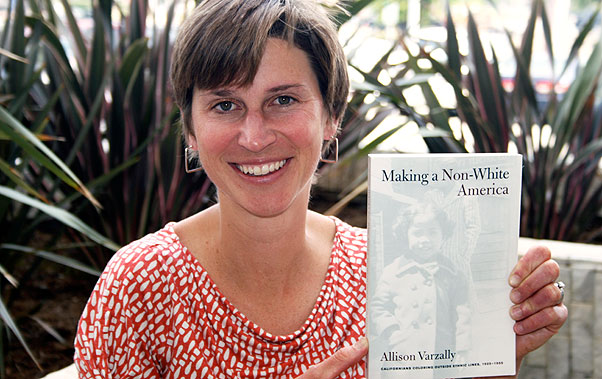‘Making a Non-White America’
Allison Varzally’s Book About California's Ethnic History Wins National Award
August 18, 2009
By Mimi Ko Cruz
Interracial marriages and other ties in diverse communities throughout California during the formative years of the 20th century are explored in Allison Varzally’s book, “Making a Non-White America: Californians Coloring outside Ethnic Lines, 1925-1955.”
Published by University of California Press, Varzally’s book has won the the Immigration and Ethnic History Society’s 2009 Theodore Saloutos Memorial Award in American Immigration History.
The award, which comes with $1,000, is presented for the book judged best on any aspect of the immigration history of the United States.
Varzally, assistant professor of history, said the honor “is exciting recognition from an organization that I admire.
“Some of my favorite books in the field have won this award,” she said.
Varzally, of Los Angeles, uses the voices from oral histories she conducted to weave a scholarly interpretation on the state’s history. She touches on World War II, the Zoot suit riots, discriminatory laws, segregation, class, politics, religion, work and education.
The book’s cover features a picture of Sugar Pie De Santo, a Filipina-black woman who grew up in San Francisco’s Fillmore District in the 1940s.
De Santo, Varzally said, “creatively and selectively borrowed from her parents’ cultures, enjoyed her blended family background and became a famous musician.”
Other vignettes from the oral histories in the book include:
- Dora Yum Kim, of Korean descent, was born in 1912 and grew up in San Francisco’s Chinatown, where “despite geopolitical and parental pressures, a sense of solidarity with other non-white ethnics shaped her acculturation.”
- Eddie Erosa was born in 1938 to a Mexican-American mother and Filipino father in the San Joaquin Valley, where such mixed-race couples were common.
- Blanche Taff, whose Jewish family moved to Los Angeles in 1920, married Bert Corona, a Mexican American who shared her political interests, in the 1930s despite parental disapproval. Their union “exemplified the powerful pull of common politics and the subversive implications of minority marriages.”
- When Mei Nakano was sent to an internment camp in Santa Anita, a black boy, Clovis Scott, who she had befriended before World War II, would visit and testified on her behalf when she applied for leave. Their story “suggests how the coming of war tested but did not break the intercultural relations and multiethnic identities that minority adolescents, adults and families had built in California.”
In “Making a Non-White America,” Varzally writes: “Amid rapid ethnoracial change, 21st-century Americans oscillate between doubts and determination that we can all get along. Will we blur as we notice the many ethnoracial lines that run through the United States? Which ones will fade and which ones will hold their color?
“Californians of multiethnic, segregated spaces in the past wrestled with these questions. They got along quite intimately, if not quite easily, forming relationships and families that crossed and faded ethnoracial divisions …. Their interactions reflected a pragmatic and discriminating approach to living in a society of true diversity.”
Varzally, who joined Cal State Fullerton’s faculty in 2005 after earning her doctorate in history from UCLA, now is working on her next book project — a history of Vietnamese adoptions by American parents from the 1960s through the 1980s.


